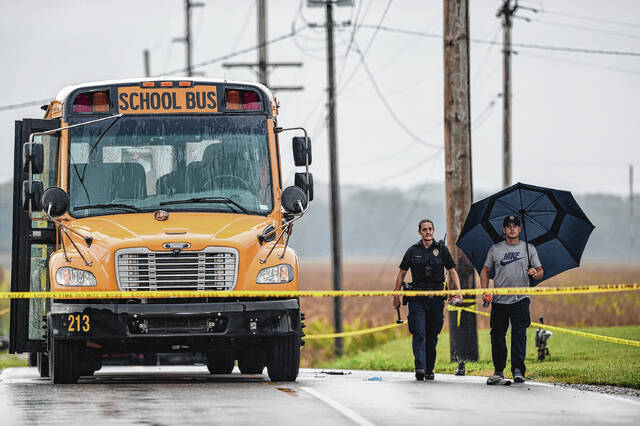
Accident investigators work the scene of a hit and run involving a student and a vehicle at a bus stop on South Gladstone Avenue in Columbus, Ind., Monday, Aug. 30, 2021. Mike Wolanin | The Republic
Bartholomew Consolidated School Corp. is considering installing stop arm cameras on all of its routed school buses by next fall in hopes of preventing violations and adding the ability to cite violators.
Director of Operations Brett Boezeman, Transportation Manager AJ McKeand and School Resource Officer Sgt. Julie Quesenbery discussed the initiative at Monday’s school board meeting.
According to school officials, 12 out of BCSC’s 120 school buses already have stop arm cameras. Boezeman said the school corporation hopes to make it a full 120 by Aug. 1, with the retrofit taking about six to eight months.
The project also entails other upgrades for buses as needed, including higher video quality and installation of dash cameras. The total cost of the stop arm additions and system upgrades is about $300,000, and the funding request will be made at a later date.
“We’ll bring an additional appropriation for funding of this project here soon, to you,” Boezeman told the school board. “Mr. (Chad) Phillips will help us with that as a cash drawdown from our operations budget to help pay for this.”
Phillips is BCSC’s assistant superintendent of financial services.
According to school officials, stop arm violations occur nearly every day in the local school district. The proposed solution is to install stop arm cameras on all routed school buses.
McKeand said that bus cameras run at all times when the ignition is on. When a violation occurs, the bus driver marks the event on the video recording, which also includes the GPS location, timestamp and bus information for these incidents. The stop arm cameras are able to pick up plate numbers even in the dark, thanks to infrared night vision.
Once marked, video is retrieved from the bus and sent to Quesenbery, along with still shots of the incident, said Boezeman. Quesenbery then runs the plate and sends a citation to the vehicle’s owner. A copy of the citation is also sent to the prosecutor’s office.
Boezeman added that BCSC is already using this process with the buses that already have stop arm cameras.
The announcement of bus camera upgrades comes about five months after the death of 16-year-old Columbus East High School student Lily J. Streeval on Aug. 30. Shiam Sunder Shankara Subramanian, 25, was arrested following Lily’s death. He is accused of attempting to drive around a stopped school bus with warning lights flashing and arm signal extended, court records state. The victim was struck as she was attempting to board the bus, according to court documents.
Formal charges filed against the defendant include leaving the scene of an accident resulting in death or catastrophic injury, a Level 4 felony, and passing a school bus when arm signal is extended causing death, a Level 5 felony.
In Indiana, it is illegal for motorists to pass a bus that is stopped, with red lights flashing and the stop arm extended.
This applies on all roads, with the exception of highways divided by a barrier, such as a cable barrier, concrete wall or grassy median — drivers on those roads only have to stop if traveling in the same direction as the school bus.
Lindsey Holden-Kay, one of the Republican candidates for Bartholomew County prosecutor, spoke up in favor of BCSC’s initiative during the time for public comment at Monday’s meeting.
“In my four years at the Bartholomew County prosecutor’s office, I kind of, by necessity, became the resident expert on trying crashes that resulted in fatalities,” she said. “And I come to you because I don’t think people realize how difficult these cases are to prosecute.”
If the incident does not involve intoxication, the case becomes more difficult, she said. Prosecutors have to show that the law was violated and that there was an element of “criminal negligence.” Having cameras will help officials take the “guesswork” out of the process and aid in both deterrence and enforcement, she said.
“This is not solely a BCSC issue,” Holden-Kay added. “This is a community issue. And as such, other community leaders should be stepping to the plate to help with this, because this initiative really affects all of us.”
When asked if school officials had seen any change in the number of stop arm violations since Lily’s death, Boezeman said that he could not speak to the quantity of infractions that occur in the city and county.
“This school year, however, there seems to be heightened awareness regarding bus stop arms processes within the community, but violations do continue almost daily as our buses cover more than 8,000 miles per day and execute hundreds of loading and unloading stops,” he said.
School officials noted the need for ongoing education to the public on this subject, as some individuals may be confused about when they are required to stop.
Superintendent Jim Roberts also mentioned that he and Boezeman would attend a hearing at the statehouse in Indianapolis to testify in favor of proposed Senate Bill 121. The legislation focuses on penalizing registered owners when their vehicle is used to commit a stop arm violation. Under the bill, the owner would be guilty of a Class B infraction but would have a viable defense if the vehicle was stolen, routinely rented, or provided to the owner’s employees for work purposes.
According to the 2020 Indiana Traffic Safety Annual Report, “The Indiana Department of Education (DOE) annually completes a statewide one-day survey to collect the number of stop arm violations reported in one single day. This number revolves near 2,000 violations daily for the last several years.”




